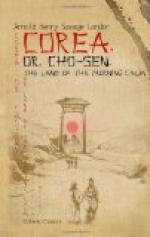Monasteries as a rule consist of the temple and the mud huts and houses of the monks and novices. The temple always stands apart. Of the temples which I saw, none were very rich in interesting works of art or in excellent decoration, like the temples of Japan. The only parts decorated outside in the Corean houses of worship are immediately under the roof and above the doors, where elaborate, though roughly executed wood-carvings are painted over in red, white, green and yellow, in their crudest tones. Over each of the columns supporting the temple, projects a board with two enormous curved teeth, like the tusks of an elephant, and over the principal door of the temple is a black tablet, on which the name of the temple is written in gold Chinese characters. At each of the columns, both of the temple and of the common part of the dwellings, hang long wooden panels on which are written the names of supporters and donors with accompanying words of high praise.
The doors of the temples are of lattice-work and are made up of four different parts, folding and opening on hinges. On some occasions, when the concours of the public is too great to be accommodated within the building itself, the whole of the front and sides of the temple are thrown open. Inside the lattice-work above mentioned tissue-paper is placed, to protect the religious winter visitors from the cold.
Inside, the temples are extremely simple. With the exception of the statue of Buddha and the various representations of minor deities that we have already mentioned, there is little else to be seen. The prayer-books, certainly, are interesting; their leaves are joined together so as to form a long strip of paper folded into pages, but not sewn, nor fastened anywhere except at the two ends, to which two wooden panels are attached, and, by one side of the book being kept higher than the other, the leaves unfold, so to speak, automatically.
In one temple of very small dimensions, perched up among the rocks near the South Gate of Seoul, are to be seen hundreds of little images in costumes of warriors, mandarins and princes, all crammed together in the most unmerciful manner. This temple goes by the name of the “The Five-hundred Images.” Adjoining it is a quaint little monastery and a weird cavern (see chap, xx., “A Trip to Poo Kan").
As to the monasteries themselves, these, though adjoining the temples, are built apart from them. Their lower portions are, like all Corean houses, of stone and mud, while the upper parts are entirely of mud. The roof is tiled on the main portion of the building, while over the kitchen and quarters for the novices it is generally only thatched.
[Illustration: BUDDHIST BONZES AND TEMPLE]




